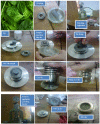Fourier Transform Infrared Spectroscopy vibrational bands study of Spinacia oleracea and Trigonella corniculata under biochar amendment in naturally contaminated soil
- PMID: 34191839
- PMCID: PMC8244852
- DOI: 10.1371/journal.pone.0253390
Fourier Transform Infrared Spectroscopy vibrational bands study of Spinacia oleracea and Trigonella corniculata under biochar amendment in naturally contaminated soil
Retraction in
-
Retraction: Fourier Transform Infrared Spectroscopy vibrational bands study of Spinacia oleracea and Trigonella corniculata under biochar amendment in naturally contaminated soil.PLoS One. 2022 Aug 3;17(8):e0272183. doi: 10.1371/journal.pone.0272183. eCollection 2022. PLoS One. 2022. PMID: 35921266 Free PMC article. No abstract available.
Abstract
Fourier transform infrared spectroscopy (FTIR) spectroscopy detects functional groups such as vibrational bands like N-H, O-H, C-H, C = O (ester, amine, ketone, aldehyde), C = C, C = N (vibrational modes of a tetrapyrrole ring) and simply C = N. The FTIR of these bands is fundamental to the investigation of the effect of biochar (BC) treatment on structural changes in the chlorophyll molecules of both plants that were tested. For this, dried leaf of Spinacia oleracia (spinach) and Trigonella corniculata (fenugreek) were selected for FTIR spectral study of chlorophyll associated functional groups. The study's primary goal was to investigate the silent features of infrared (IR) spectra of dried leave samples. The data obtained from the current study also shows that leaf chlorophyll can mask or suppress other molecules' FITR bands, including proteins. In addition, the C = O bands with Mg and the C9 ketonic group of chlorophyll are observed as peaks at1600 (0%BC), 1650 (3%BC) and 1640, or near to1700 (5%BC) in spinach samples. In fenugreek, additional effects are observed in the FTIR spectra of chlorophyll at the major groups of C = C, C = O and C9 of the ketonic groups, and the vibrational bands are more evident at C-H and N-H of the tetrapyrrole ring. It is concluded that C-N bands are more visible in 5% BC treated spinach and fenugreek than in all other treatments. These types of spectra are useful in detecting changes or visibility of functional groups, which are very helpful in supporting biochemical data such as an increase in protein can be detected by more visibility of C-N bands in FTIR spectra.
Conflict of interest statement
The authors have declared that no competing interests exist.
Figures





Similar articles
-
Retraction: Fourier Transform Infrared Spectroscopy vibrational bands study of Spinacia oleracea and Trigonella corniculata under biochar amendment in naturally contaminated soil.PLoS One. 2022 Aug 3;17(8):e0272183. doi: 10.1371/journal.pone.0272183. eCollection 2022. PLoS One. 2022. PMID: 35921266 Free PMC article. No abstract available.
-
Role of cotton sticks biochar in immobilization of nickel under induced toxicity condition and growth indices of Trigonella corniculata L.Environ Sci Pollut Res Int. 2020 Jan;27(2):1752-1761. doi: 10.1007/s11356-019-06466-3. Epub 2019 Nov 22. Environ Sci Pollut Res Int. 2020. PMID: 31758478
-
Biochar counteracts nitrification inhibitor DMPP-mediated negative effect on spinach (Spinacia oleracea L.) growth.Ecotoxicol Environ Saf. 2020 Mar 15;191:110243. doi: 10.1016/j.ecoenv.2020.110243. Epub 2020 Jan 27. Ecotoxicol Environ Saf. 2020. PMID: 32001421
-
Using biochar for remediation of soils contaminated with heavy metals and organic pollutants.Environ Sci Pollut Res Int. 2013 Dec;20(12):8472-83. doi: 10.1007/s11356-013-1659-0. Epub 2013 Apr 16. Environ Sci Pollut Res Int. 2013. PMID: 23589248 Review.
-
Fourier transform infrared spectroscopy of primary electron donors in type I photosynthetic reaction centers.Biochim Biophys Acta. 2001 Oct 30;1507(1-3):180-93. doi: 10.1016/s0005-2728(01)00206-7. Biochim Biophys Acta. 2001. PMID: 11687214 Review.
Cited by
-
Using mathematical models to evaluate germination rate and seedlings length of chickpea seed (Cicer arietinum L.) to osmotic stress at cardinal temperatures.PLoS One. 2021 Dec 17;16(12):e0260990. doi: 10.1371/journal.pone.0260990. eCollection 2021. PLoS One. 2021. Retraction in: PLoS One. 2022 Aug 3;17(8):e0272196. doi: 10.1371/journal.pone.0272196. PMID: 34919542 Free PMC article. Retracted.
-
Characterization and Application in Natural Rubber of Leucaena Leaf and Its Extracted Products.Polymers (Basel). 2023 Sep 8;15(18):3698. doi: 10.3390/polym15183698. Polymers (Basel). 2023. PMID: 37765552 Free PMC article.
-
Retraction: Fourier Transform Infrared Spectroscopy vibrational bands study of Spinacia oleracea and Trigonella corniculata under biochar amendment in naturally contaminated soil.PLoS One. 2022 Aug 3;17(8):e0272183. doi: 10.1371/journal.pone.0272183. eCollection 2022. PLoS One. 2022. PMID: 35921266 Free PMC article. No abstract available.
-
Removal of active pharmaceutical compounds in Primalan and Diane using pumpkin biochar: synthesis, characterization, and adsorption study.RSC Adv. 2025 Jan 30;15(5):3066-3079. doi: 10.1039/d4ra07917e. eCollection 2025 Jan 29. RSC Adv. 2025. PMID: 39885859 Free PMC article.
-
Integrated Biochar-Compost Amendment for Zea mays L. Phytoremediation in Soils Contaminated with Mining Tailings of Quiulacocha, Peru.Plants (Basel). 2025 May 12;14(10):1448. doi: 10.3390/plants14101448. Plants (Basel). 2025. PMID: 40431013 Free PMC article.
References
-
- Zafar-Ul-hye M, Naeem M, Danish S, Fahad S, Datta R, Abbas M, et al.. Alleviation of cadmium adverse effects by improving nutrients uptake in bitter gourd through cadmium tolerant rhizobacteria. Environ—MDPI. 2020;7: 54. doi: 10.3390/environments7080054 - DOI
-
- Danish S, Younis U, Nasreen S, Akhtar N, Iqbal MT. Biochar consequences on cations and anions of sandy soil. J Biodivers Environ Sci. 2015;6: 121–131.
-
- Pickin J, Randell P. Australian National Waste Report 2016. Aust Gov Dep Environ Energy. 2017.
Publication types
MeSH terms
Substances
LinkOut - more resources
Full Text Sources
Research Materials
Miscellaneous

